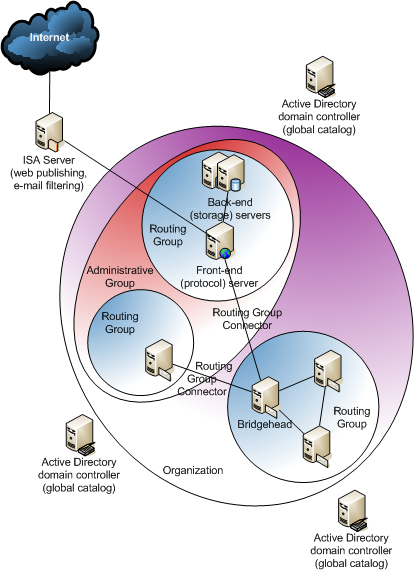For anyone who is new to Exchange Server 2003, here’s a brief overview that may be of use.
Microsoft Exchange Server 4.0 was launched in 1996, as a replacement for Microsoft Mail 3.x. It was Microsoft’s first groupware product, competing directly with Novell GroupWise and Lotus Notes. Later versions (v5.0, v5.5) added functionality and improved the scalability of the solution, with Exchange Server 5.5 being the version which really took a hold on the market. Exchange 2000 (v6.0) was a major rewrite, leaving behind its own directory service and using Active Directory instead (which is based on the Exchange Directory technology), and featuring a new system of storage groups supporting multiple mailbox and private stores (for improved database backup and restoration times). Exchange 2000 also switched its internal message transport protocol from X.400 to SMTP, making use of (and extending) the SMTP features in Microsoft Internet Information Services (IIS). Microsoft Exchange Server 2003 (v6.5) builds on the scalability, reliability, performance and manageability of Exchange Server 2000 and is the current version, albeit without conferencing, instant messaging and chat features, which have been replaced by the Microsoft Office Live Communications Server product.

The Exchange environment is known as an organization. Within an organization, Exchange Server 4.0-5.5 divides the infrastructure into one or more sites (similar to the Active Directory site concept), linked by connectors of varying types (e.g. RPC, X.400). Exchange Server 2000 and 2003 use routing groups instead of sites, and also introduce the concept of administrative groups for organisations where administration is undertaken by different groups of staff (e.g. in a global organisation with separate teams for Americas, EMEA and Asia-Pacific).
Exchange servers may be configured for a variety of specialist purposes:
- A bridgehead, is a server dedicated to routing e-mail for a routing group.
- Front end (protocol) servers act as concentrators for client connections, where protocol conversion would be an overhead (e.g. HTTP connections using Outlook Web Access).
- Back end (storage) servers could be mailbox servers, public folders servers, or a combination of the two.
- There may also be other servers dedicated to providing services such as fax connections, mail archival and retrieval (near-line storage), or instant messaging.
Because Exchange Server 2000 and 2003 use Active Directory, Exchange servers require a global catalog server to be placed nearby. Other products, such as Microsoft ISA Server 2004 may also be used to increase security, for example filtering inbound e-mail, or publishing an Outlook Web Access (OWA) server.
Links
Microsoft Exchange Server
Microsoft Exchange Server resource site